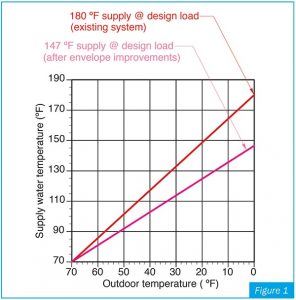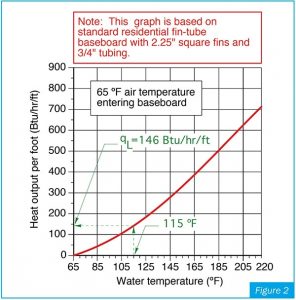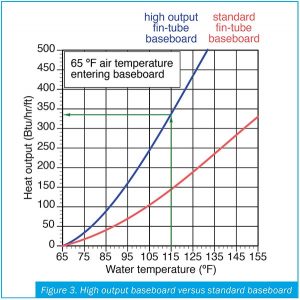
Lowering the bar – part I: Modifying high-temp distribution systems
February 23, 2018 | By John Siegenthaler
What characteristic do solar thermal collectors, hydronic heat pumps and thermal storage tanks supplied by biomass boilers have in common? Answer: They all perform best when coupled to distribution systems that operate at low supply water temperatures.
But that is not what is waiting for them in many North American homes. It is common to encounter situations where a modern low temperature heat source is to be added to distribution systems that were originally designed to operate at relatively high temperature, such as 180F. If the installer just removes the original “box” that supplied this high temperature water, and drops the new renewable energy heat source into its place, trouble is sure to follow.
Related: Lowering the bar — part II: using heat emitters
For example, most current generation water-to-water and air-to-water heat pumps can only produce water temperatures in the range of 120F to 130F. If saddled to distribution systems that are sized to release design load output at 180F average water temperature, some heat pumps would quickly trip off on a high temperature limit, requiring a manual reset after each trip. The existing distribution systems simply cannot dissipate the rate of heat input from the heat pump with a water temperature that is 50F to 60F lower than it was designed for.
Moving downward
The are two fundamental ways to reduce the supply water temperature of any hydronic heating system:
- Reduce the design load of the building envelope through improvements such as added insulation, better windows and lower air leakage.
- Add heat emitters to the existing system.
A combination of these two approaches is also possible. Building envelope improvements reduce the design heating load of the building. After these improvements are made, existing hydronic distribution systems can meet the reduced design load while operating at lower supply water temperatures. The change in supply water temperature is proportional to the change in design heating load. The new supply water temperature can be determined based on the same concepts used for outdoor reset control. It can be calculated using Formula 1.
Formula 1:
Tnew – Tin + (Qnew/Qexisting) X (Tde – Tin)
Where:
Tnew = supply water temperature at design load after building envelope improvements (ºF)
Tin = desired indoor air temperature (ºF)
Qnew = design heating load after building envelope improvements (Btu/hr)
Qexisting = existing design heating load before improvements (Btu/hr)
Tde = existing supply water temperature at design load before improvements (Btu/hr)
For example, assume a building has a design heating load of 100,000 Btu/hr, based on maintaining an interior temperature of 70F. The existing hydronic distribution system uses standard finned-tube baseboard and requires a supply water temperature of 180F at design load conditions. Also assume that improvements to the building envelope have reduced the design load from 100,000 Btu/hr to 70,000 Btu/hr. The new supply water temperature to the existing distribution system under design load conditions is calculated using Formula 1.
Formula 1
Tnew = 70 + (70,000/100,000) X (180 – 70) = 140F
Figure 1 shows the supply water temperature versus outdoor temperature for the original load, as well as the reduced load after the building envelope improvements were made.
In this case, reducing the design heating load from 100,000 Btu/hr to 70,000 Btu/hr reduced the required supply water temperature from 180F to 147F. Although this is certainly an improvement, it is still substantially above what some renewable energy heat sources can consistently provide.
More emitters

If reducing the design heating load of the building does not lower the required water temperature to the desired value, it will be necessary to add heat emitters to the system.
If the original system used finned-tube baseboard heat emitters, it may be possible to add more of the same emitters. Another option might be to change out some existing baseboard for high output baseboard. It is also possible to add different types of heat emitters, such as panel radiators, fan-coils, or select areas of radiant panels.
The choice of which type of heat emitter to add will depend on several factors, including:
- Availability of different makes/models of heat emitters.
- Cost of the new heat emitters.
- How difficult it is to integrate the new heat emitters into the building.
- Aesthetic preferences.
- Floor coverings (in the case of radiant floor panels).
- Surface temperature limitations (in the case of radiant panels).
- The specific supply water temperature that is to supply design load output in the renovated distribution systems.
More baseboard

Let’s proceed with the assumption that more finned-tube baseboard will be added. The following procedure can be used to calculate the amount of baseboard to be added to reduce the supply water temperature at design load to a pre-determined value. It assumes that the added baseboard is the same make and model as the existing baseboard. It also assumes that the existing baseboard is a standard residential-grade product with nominal 2.25 in. square aluminum fins with an I=B=R rated output of approximately 600 Btu/hr/ft at 200F water temperature.
Step 1: Accurately determine the building’s design heat load using Manual J or equivalent procedures.
Step 2: Determine the total length of finned-tube in the existing distribution system. Do not include the length of tubing that doesn’t have fins on it. The existing finned-tube length will be designated as Le.
Step 3: Determine the desired (lower) supply water temperature for which the system is to supply design load output. A suggested value is 120F.
Step 4: Estimate the lower average circuit water temperature by subtracting five to 10F from the supply water temperature determined in Step 3.
Step 5: Find the new average circuit water temperature on the horizontal axis of the graph in Figure 2. Draw a vertical line up from this point until it intersects the red curve. Draw a horizontal line from this intersection to the vertical axis of the graph, and read the heat output of the finned-tube at the lower average circuit water temperature. This number is designated as qL. The green lines and numbers in Figure 2 show how qL is determined for an average circuit water temperature of 115F.
Step 6: Determine the length of baseboard to be added using Formula 2.
Formula 2
Ladded = design load/qL – Le
Where:
Ladded = length of finned-tube of same make/model baseboard to be added (feet)
design load = design heating load of building (Btu/hr)
qL = output of baseboard at the lower average circuit water temperature (Btu/hr/ft)
Le = total existing length of baseboard in system (feet)
Here is an example. Assume a building has a calculated design load of 40,000 Btu/hr, and its distribution system contains 120 ft. of standard residential finned-tube baseboard. A conventional cast iron boiler currently heats it. The goal is to reduce the supply water temperature to 120F at design conditions, using more of the same baseboard. Assume the temperature drop of the distribution system is 10F. Determine the amount of baseboard that must be added:
Solution:
Step 1: The design load has been calculated as 40,000 Btu/hr.
Step 2: The total amount of finned-tube in the system is 120 ft.
Step 3: The lower supply water temperature at design load will be 120F.
Step 4: The lower average circuit water temperature will be 120 – (10/2) = 115F.
Step 5: The output of the finned-tube at an average circuit water temperature of 115F is determined from Figure 6-10 as 146 Btu/hr/ft.
Step 6: The required additional length of baseboard is now calculated using Formula 2.
Formula 2
Ladded = design load/qL – Le = [40,000 Btu/hr/146 Btu/hr∙ft– 120] = 154 ft
Although it might be possible to add 154 ft. of baseboard to the system, it would require lots of wall space. In most buildings, adding this much baseboard is not a practical solution. Alternatives include using baseboard with higher heat output or using other types of heat emitters to achieve the necessary design load output.
 Another option is to consider adding high output finned-tube baseboard rather than standard baseboard. Figure 3 shows the heat available from high output baseboard (shown as the blue curve) and, for comparison, standard residential baseboard (shown as the red curve).
Another option is to consider adding high output finned-tube baseboard rather than standard baseboard. Figure 3 shows the heat available from high output baseboard (shown as the blue curve) and, for comparison, standard residential baseboard (shown as the red curve).
The steps of the previous procedure can be modified to determine the amount of high output finned-tube baseboard that is required to reduce the supply water temperature to the system under design load.
Steps 1 to 4: Same.
Step 5: Determine the output of high output baseboard at the average circuit water temperature using Figure 3 (or manufacturer’s literature for a specific make and model).
Step 6: The required length of high output baseboard to add to the system is found using Formula 3.
Formula 3
Lho = design load – (qL)(Le)/qho
Where:
Lho = length of high output finned-tube baseboard to be added (feet)
design load = design heating load of building (Btu/hr)
qL = output of existing baseboard at the lower average water temperature (Btu/hr/ft)
Le = total existing length of baseboard in system (feet)
qho = output of high output baseboard at the lower average water temperature (Btu/hr/ft)
Here is another example: Assume a building has a calculated design load of 40,000 Btu/hr and its distribution system contains 120 feet of standard residential finned-tube baseboard. The goal is to reduce the supply water temperature under design load to 120F. Additional high output baseboard will be added to allow this lower water temperature operation.
Assume that the temperature drop of the distribution system at design load is 10F and this existing baseboard has the same output as in the previous example (146 Btu/hr/ft at average circuit water temperature of 115F). Determine the amount of high output baseboard required based on the performance shown in Figure 3.
Solution:
Step 1: The design load has been calculated as 40,000 Btu/hr.
Step 2: The total amount of finned-tube in the system is 120 feet.
Step 3: The new lower supply water temperature at design load will be 120F.
Step 4: The new lower average circuit water temperature will be 120 – 5 = 115F.
Step 5: The output of high output finned-tube baseboard at an average water temperature of 115F is determined from Figure 7 as 335 Btu/hr/ft.
Step 6: The required length of high output baseboard to add to the system is found using Formula 3.
Formula 3
Lho = design load – (qL)(Le)/qho = 40,000-(146)(120)/335 = 67 ft
Although this is a substantial reduction compared to the 154 ft. of additional standard baseboard required in the previous example, it is still a substantial length. The building must be carefully evaluated to see if this additional length of baseboard can be accommodated.
If the added length of high output baseboard cannot be accommodated, another option is to raise the supply water temperature constraint from 120 to 130F under design load conditions. This would reduce the amount of added high output baseboard to 40 ft.
Adding other heat emitters
If the amount of finned-tube baseboard that needs to be added is beyond what can be accommodated, there are several other added heat emitter options. These include panel radiators, fan-coils, or areas of radiant floor, radiant wall or radiant ceiling panels. In each case, the selection of these new heat emitters should be based on a selected supply water temperature at design load, along with a “credit” for the existing heat emitters in the system operating at the lower supply water temperature. The fundamental concept is shown in Formula 4.
Formula 4
Qn = design load – Qe
Where:
Qn = required heat output of the new heat emitters at lower supply water temperature (Btu/hr)
design load = the design heating load of the building (Btu/hr)
Qe = heat output of existing heat emitters at the lower supply water temperature (Btu/hr)
Once the value of Qn is determined, the designer can use tables or graphs from manufacturers to determine the heat output of specific heat emitters based on the average water temperature within them. Remember that the average water temperature will be five to 10F lower than the supply water temperature.
The goal is to select a grouping of new heat emitters with a total heat output that’s approximately equal to the value of Qn in Formula 4.
Let’s work through another example. Assume a building has a calculated design load of 40,000 Btu/hr, and its distribution system contains 120 ft. of standard residential finned-tube baseboard. The goal is to reduce the supply water temperature to 120F under design load conditions. Panel radiators are available in 24 in. x 72 in., which can release 4,233 Btu/hr when operated at an average water temperature of 115F in rooms with 70F interior temperature. How many of these radiators are necessary to meet the design load?
Solution: First, use Formula 4 to determine the output required of the new radiators.
Qn = design load – Qe = design load – (qL)(Le) = 40,000 – (146)(120) = 22,480 Btu/hr
The number of radiators needed is then found as follows:
22,480 Btu/hr/4233 Btu/hr/radiator = 5.3 radiators
The designer could either add six of these panel radiators, or choose a slightly higher supply water temperature and use five radiators.
Another option is to use panel radiators of different sizes, provided that the total output at the lower supply water temperature could meet the value of Qn. In this example, the six new radiators would be combined with the 120 ft. of existing baseboard to provide the 40,000 Btu/hr design load.
A similar calculation could be made for fan-coils, air handlers or other heat emitters.
In the case or radiant panels, the designer needs to determine the output of each square foot of panel based on the lower average circuit temperature and the specific construction of the panel. The total required panel area is found by dividing this number into the value of Qn.
Piping options
Once the amount of additional baseboard is determined, designers can turn their attention to how it should be piped into distribution systems. That will be discussed in Part II.




